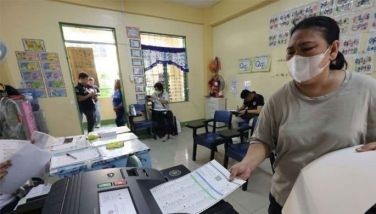A ‘cloud’ hovers over rice research and other agricultural innovations
MANILA, Philippines - Cloud computing is not a new idea anymore, but it is one that has become synonymous to innovation and whose applications continue to have a large-scale impact on organizations and industries.
When you start using shared computing resources delivered over the Internet instead of building your own infrastructure — storage, servers and machines — something radically changes within.
Take the case of the International Rice Research Institute (IRRI), the world’s premier research organization established to reduce poverty and hunger through rice science.
In an exclusive interview with The STAR, Dr. Marco van den Berg, IRRI’s chief technology officer, said that cloud has provided many advantages to IRRI. “This model of ‘on-demand’ and ‘pay as you go,’ ‘pay what you need’ and only pay when you actually use it (service) is very applicable to our line of business,” he said. “We are a publicly funded institution. Our donors don’t like to see us build big data centers with a lot of equipment. They’d rather see us use the money to do data processing without owning it.”
Headquartered in Los Baños-Laguna, IRRI works with partners across the globe and has offices in 17 rice-growing countries in Asia and Africa. Understandably, agricultural research, education, collaboration, implementing strategies are big components of its work.
RICE MONITORING SYSTEM
One of IRRI’s projects that benefited hugely from cloud computing is the Philippine Rice Information System (PRiSM), a rice monitoring system designed to enhance rice production in the Philippines.
“What we do is we obtain data from a satellite and that data is sent to us every month normally. That’s a large data set. It covers the entire Philippines,” Van den Berg explained. “We analyze these data sets using large-scale computing platforms, for example, to tell us what is the level of the rice crop on the ground.”
By using the cloud platform such as the Amazon Web Services (AWS) cloud, he said IRRI does not need to have all the machines on site. It doesn’t have to pay either for all the machines it is going to use but could switch them on when needed.
“I cannot just switch on one. I can switch on 10 machines if I really need it fast and divide the workload over 10 computers,” he said.
Information collected by PRiSM is made available, through a web portal, to the Department of Agriculture (DA) and decision-makers to guide policy, planning, and disaster-response activities related to rice production.
This information comes in the form of maps, statistics, and reports, and covers rice production area, crop health, crop losses due to natural calamities, and assessment of and extent of pest damage.
It is very unfortunate, according to Van den Berg, that when Typhoon Lando (international code name Koppu) hit the Philippines, for example, last October, it was almost harvest time and damage to crops was massive and immediately known.
SMALL-SCALE FARMING AND THE ‘CLOUD’
He emphasised, however, that if the technology is to be made more relevant to farmers’ lives, IRRI needs to be able to link small-scale farming to cloud computing capability. And this it does through the Rice Crop Manager, an application that runs on a mobile platform that asks farmer questions about their work and their crops.
“Not all farmers have tablets or mobile phones, but more and more of them do. In the Philippines, there are more mobile phones than people. Not all farmers have flashy mobile phones but in many instances there would be people helping the farmers such as extension agents or specialists or sometimes even family members,” Van den Berg said.
“They ask questions like what rice variety did you use last year, how much fertilizer did you apply last year. We put all those answers in a mobile and against a couple of databases. The answers are transmitted to the cloud. In the cloud, we are able to look into the database very fast and run those crop models and we are able to immediately provide customized recommendations for the farmer,” he added.
These recommendations may include recommendations to apply fertiliser on certain dates, and on what amounts. Experts know traditional fertilizer applications use too much fertilizer and not at the most efficient stage of crop development.
“The end result of this is that farmers are able to use less fertilizer at less cost and get higher yields. It also causes less environmental pollution because fertilizer that is not used by the crop ends up in lakes and it is not good,” Van den Berg said.
BIG DATA ON 3,000 RICE GENOMES
Earlier this year, the IRRI and two other research institutions — the Chinese Academy of Agricultural Sciences (CAAS) and the Beijing Genomics Institute (BGI) Shenzhen, and IRRI — collaborated to sequence the genomes of 3,024 rice varieties and lines housed in the IRRI (82 percent) and the CAAS (18 percent) gene banks.
The sequencing and initial analysis were funded by grants from the Bill & Melinda Gates Foundation and the Chinese Ministry of Science and Technology. This dataset contains millions of genomic sequences from a diverse set of rice varieties that, when combined with phenotyping observations, gene expression, and other information, provides an important step in establishing gene-trait associations, building predictive models, and applying these models to breeding.
Through funding from the Global Rice Science Partnership, the 3,024 genomes were re-analyzed against five popular varieties that represent the three main subgroups of cultivated rice.
This new 3K RGP data analysis set is massive at 120 terabytes, which is well beyond the computing capacities of most research institutions. However, these new results are now publicly available online, as an Amazon Web Services (AWS) Public Data Set.
Accessing the data is free, and use is governed by the stipulations for data analysts and users from the Toronto Statement.
“The dataset provides access to millions of genetic markers that can be used to design sustainable crops for the future, that is, ones that are high-yielding and more nutritious while at the same time requiring less water, fertilizer, and pesticides,” said Dr. Rod Wing, director of the Arizona Genomics Institute at the University of Arizona and a pioneer in rice genome sequencing.
Van den Berg added that what is fascinating about being able to store these reference information on over 3,000 rice varieties in the cloud is that researchers can now do an analysis of the type they probably never dreamed of.
“I think this is where AWS and other cloud providers are seeing opportunity. People are worried about food security, rice breeding. They are now able to look at the tons of data made available and they can make use of the facility to analyze it,” he said.
- Latest

























